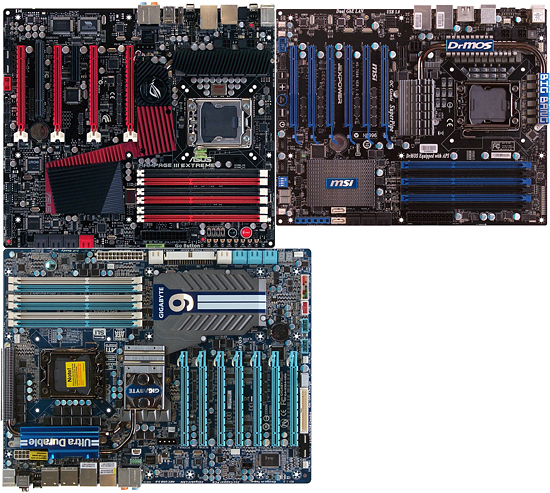X58 To The Max: Three New Flagship LGA 1366 Motherboards
Supporting Intel’s highest-performance processors with twice the bandwidth of its mainstream counterpart, the X58 chipset proves the staying power of good ideas. We take a closer look at what makes the latest generation of premium motherboards special.
More Power!
One word explains how Intel’s oldest Core i7 chipset has been able to dominate the high-end desktop market for an impressive two years: more. More PCI Express (PCIe) 2.0 pathways feed more high-bandwidth expansion cards. More memory channels on the socket increase bandwidth to more physical CPU cores, while new models, like the Core i7-980X and Xeon X5600-series chips, are introduced.
Yet because the concept of more always translates to cost, manufacturers are constantly looking to pack more features into these already-more-expensive motherboards.
Our most recent “more” article for X58 motherboards examined boards with USB 3.0 and SATA 6 Gb/s controllers, two items that take advantage of the X58’s four left over PCIe 2.0 pathways. Intel solutions aren’t completely comparable, since Intel's LGA 1156 platform only has 16 lanes to begin with. It might surprise you then that the latest trend in more doesn't have anything to do with additional connectivity at all.

Top LGA 1366 motherboards now feature two eight-pin ATX12V/EPS12V power connectors to enable enhanced power delivery under the rigors of extreme overclocking. Builders whose overclocking needs are less intensive will still find that a single connector works, while those running at stock speeds will even find a four-pin connector adequate. Today we consider the totality of features, performance, and stability of the three latest examples of flagship-class X58-based platforms.
Get Tom's Hardware's best news and in-depth reviews, straight to your inbox.
-
one-shot No EVGA SR-2? :(Reply
Ok, Hold on. Three Flagship LGA 1366 Boards and no overclocked power consumption results? These boards are obviously made for overclocking and those results would be very interesting to see. -
Lmeow Reply9498281 said:No EVGA SR-2? :(
The EVGA Classified SR-2 is based on the Intel 5520 chipset and uses Xeons, so it's not an X58 board technically speaking which is why it doesn't qualify. ;)
If I could spend that much on a motherboard I'd have chosen the Rampage III Extreme, not only does it have good features it also has the best colour scheme. ^^
Does anyone know why I try to submit a comment it doesn't show up, and I have to use the forums instead to post a comment instead? -
sudeshc I am totally impressed by ASUS they always come up with best solution in every category, but the price is a killer for me :(Reply
-
rottingsheep IMO, the only interesting part about motherboard reviews is the overclocking and power consumption portion.Reply -
avatar_raq Nice article..I have only catch: Of all the mobos tested, Quad SLI is not possible on the ASUS R3E, courtesy of nVIDIA's driversReply
http://www.guru3d.com/news/quad-sli-on-asus-rampage-iii-extreme-is-not-possible/ -
dragonfang18 Whats the point when Intel will come out with new processors with different sockets next year?Reply -
Crashman avatar_raqNice article..I have only catch: Of all the mobos tested, Quad SLI is not possible on the ASUS R3E, courtesy of nVIDIA's drivershttp://www.guru3d.com/news/quad-sl -possible/Awesome, thanks. Manufacturers don't actually discuss this stuff.Reply
dragonfang18Whats the point when Intel will come out with new processors with different sockets next year?That's what people like you were saying months before LGA 1156 was released. We see which direction that went. -
dragonfang18 ReplyThat's what people like you were saying months before LGA 1156 was released. We see which direction that went.
Yeah... they are changing 1366 to some socket R... Well... At least I can look forward to these motherboards going down in price by next year when they go to Socket R's for performance than 1366's. I guess ill be happy with 1366's. Hopefully they go down by at least $100.
